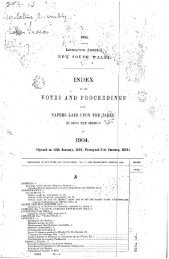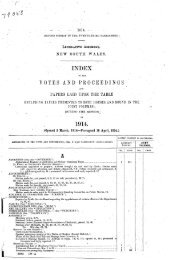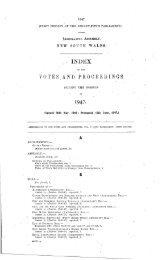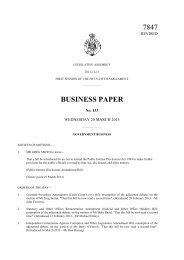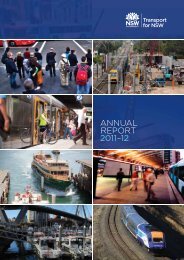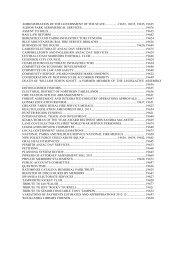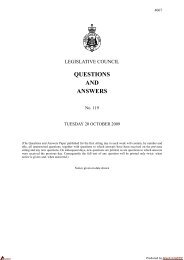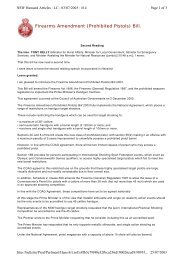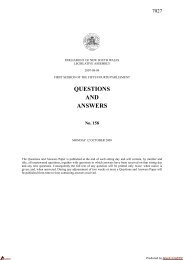Endeavour Energy Annual Performance Report - Parliament of New ...
Endeavour Energy Annual Performance Report - Parliament of New ...
Endeavour Energy Annual Performance Report - Parliament of New ...
Create successful ePaper yourself
Turn your PDF publications into a flip-book with our unique Google optimized e-Paper software.
Equal employment<br />
opportunity<br />
As part <strong>of</strong> our ‘Bridging the Gap’<br />
Aboriginal Employment Strategy,<br />
we ran an Indigenous development<br />
program in conjunction with TAFE.<br />
Eleven participants commenced<br />
the program, with two participants<br />
commencing an apprenticeship with<br />
<strong>Endeavour</strong> <strong>Energy</strong>.<br />
We also developed a new program<br />
to enable employees who are away<br />
from the workplace for extended<br />
periods on long-service, sick or<br />
parental leave to keep in touch with<br />
changes and information relevant<br />
to their work.<br />
To support working families,<br />
<strong>Endeavour</strong> <strong>Energy</strong> continues to<br />
provide an onsite childcare facility<br />
at Huntingwood. Employees who<br />
have children in the centre may pay<br />
for the service from their pre-tax<br />
earnings. In addition, we continue to<br />
<strong>of</strong>fer 14 weeks’ paid parental leave<br />
(or 28 weeks at half pay) or one week<br />
paid paternity leave to employees<br />
after the birth <strong>of</strong> a child.<br />
<strong>Endeavour</strong> <strong>Energy</strong> also began<br />
the process <strong>of</strong> benchmarking<br />
itself against similar organisations<br />
to find other areas for<br />
potential improvement.<br />
Equal employment opportunity statistics<br />
Trends in the representation <strong>of</strong> equal employment opportunity groups (% <strong>of</strong> total staff, excluding casual staff)<br />
Representation<br />
Benchmark<br />
or target<br />
(%) a 2006–07 2007–08 2008–09 2009–10 2010–11<br />
Women 50.0 22 22 20.7 20.7 20.0<br />
Aboriginal people and<br />
Torres Strait Islanders 2.6 0.9 1 0.9 1.0 1.0<br />
People whose language first<br />
spoken as a child was not English 19.0 8 8 7.7 8.1 8.8<br />
People with a disability N/A 4 4 3.9 3.7 3.6<br />
People with a disability requiring<br />
work-related adjustment 1.5 0.5 0.3 0.3 0.2 0.2<br />
a Set by NSW Government<br />
Note: Employee numbers are as at 30 June<br />
Trends in the distribution <strong>of</strong> equal employment opportunity groups (Distribution Index)<br />
Distribution Index Benchmark 2006–07 2007–08 2008–09 2009–10 2010–11<br />
Women 100 100 103 105 106 105<br />
Aboriginal people and<br />
Torres Strait Islanders 100 96 97 100 99 94<br />
People whose language first<br />
spoken as a child was not English 100 112 115 116 113 115<br />
People with a disability 100 99 101 103 104 104<br />
People with a disability requiring<br />
work-related adjustment 100 – – – – –<br />
Note 1:<br />
A Distribution Index <strong>of</strong> 100 indicates that the centre <strong>of</strong> the distribution <strong>of</strong> the EEO group across salary levels is equivalent to that <strong>of</strong> other<br />
employees. Values less than 100 mean that the EEO group tends to be more concentrated at lower salary levels than is the case for other employees.<br />
The more pronounced this tendency, the lower the index will be. In some cases the index may be more than 100, indicating that the EEO group is less<br />
concentrated at lower salary levels.<br />
Note 2: The Distribution index is not calculated where the EEO group or non-EEO group numbers are less than 20.<br />
<strong>Endeavour</strong> <strong>Energy</strong> <strong>Annual</strong> <strong>Performance</strong> <strong>Report</strong> 2010–11<br />
31



